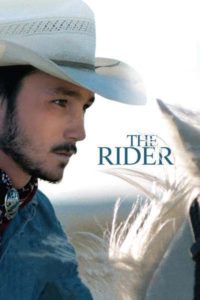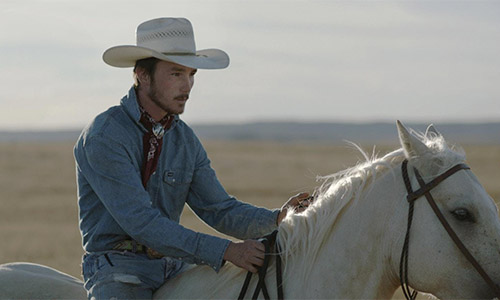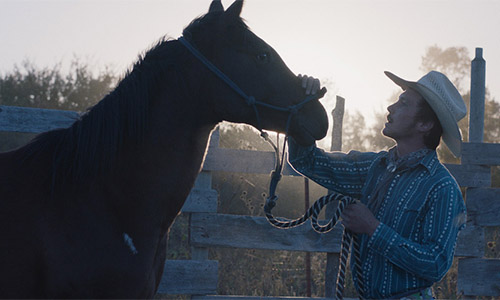 The best thing going for Chloé Zhao’s (Songs My Brothers Taught Me, Nomadland) The Rider is its authenticity. The plot is not that different than hundreds of other movies you’ve seen before. Yet, it feels refreshingly new and authentic simultaneously, due primarily to the vision of the young and talented Zhao and the decisions she made along the way. This includes her hiring of locals to play all of the characters in the film, her choice of setting (Pine Ridge Indian Reservation), her hiring of cinematographer Joshua James Richards to capture the exhaustive landscape of the South Dakota reservation, and her decision of filming this to almost feel like a documentary. Every decision she made worked. Film purists will love this. Those who need the flare or forced attempts to bring out the sentiment might be disappointed. I found myself to be somewhere in the middle. The film has a 97% fresh rating on Rotten Tomatoes (83% audience rating). That feels right for the critics and a little high for the audience score. I likely would not have seen this movie if a longtime friend hadn’t recommended it. While I wouldn’t say I liked it as much as she did, it was a good recommendation.
The best thing going for Chloé Zhao’s (Songs My Brothers Taught Me, Nomadland) The Rider is its authenticity. The plot is not that different than hundreds of other movies you’ve seen before. Yet, it feels refreshingly new and authentic simultaneously, due primarily to the vision of the young and talented Zhao and the decisions she made along the way. This includes her hiring of locals to play all of the characters in the film, her choice of setting (Pine Ridge Indian Reservation), her hiring of cinematographer Joshua James Richards to capture the exhaustive landscape of the South Dakota reservation, and her decision of filming this to almost feel like a documentary. Every decision she made worked. Film purists will love this. Those who need the flare or forced attempts to bring out the sentiment might be disappointed. I found myself to be somewhere in the middle. The film has a 97% fresh rating on Rotten Tomatoes (83% audience rating). That feels right for the critics and a little high for the audience score. I likely would not have seen this movie if a longtime friend hadn’t recommended it. While I wouldn’t say I liked it as much as she did, it was a good recommendation.
The film might suffer from its title more than anything else. I recall seeing posters from this film when I investigated the movie poster with its title and instantly thought, “Nicholas Sparks novel.” I was so convinced that I didn’t even explore it further. This was anything but, and I blame the marketing of this movie as a deterrent to its commercial success. As mentioned, this is not a story we haven’t seen played out on the screen before. It might be the most overplayed plot in film history. A person, successful at their craft, has to change the trajectory of their life after an incident (or incidents) happen for them to do so. What’s different is the content. Brady (Brady Jandreau), our protagonist, is a rodeo star, doing the whole 8 seconds thing, trying to stay on a bucking horse that wants nothing more than to throw this unwanted man off his back. A good bronc rider (yes, this is the term) can stay on even the wildest of horses more frequently than others. Brady was one of the best, at least in the local community. There is not much of a regional scene, let alone a national scene. Brady and the other riders compete near their homes in state fairs and other events. And while a paycheck motivates these men, it is more a way of life than a dream of massive success. And that is evident with the mild Brady, one of the most likable characters you’ll see on screen in 2018.

In the film’s opening scenes, we meet Brady in a dark room in his small home. He’s attempting to remove some thick staples from his head. Though I don’t believe we ever see the particular incident (though we do see plenty of 8-second rides via YouTube from Brady’s phone throughout the movie), we learn that this once-rising star on the rodeo circuit was knocked off of a wild horse at a recent bronc riding competition. As a result of the horse’s hoof landing straight on his skill, Brady suffered so much brain damage that his brain sent seizures to other parts of his body. This includes the motor functioning of his right hand, which hampers his functions so much that he often has to peel his hand open each time he clutches it. Brady lives at home with his set in his ways father, Wayne (Tim Jandreau), and autistic sister, Lily (Lilly Jandreau). Horses, horse training, and horse riding are what his family, friends, and community do. It’s what they know. It is the only career path that Brady knows. He has yet to gain other skills besides training and riding horses. He takes a local grocery store job and spends his shift stocking shelves, working the register, cleaning bloody knives in the meat room, or mopping floors. He convinces himself and others that it is only temporary while his body heals to the point where he can ride again. It becomes all too real when a young boy and his older brother recognize him and ask for a picture with the local star. The young boy wonders why one of his heroes was fronting women’s deodorant in the personal care aisle of the market.
Brady and his rodeo friends have a loving relationship. He had had the most success of his group of four, and all knew it. It’s delicate when they all talk about Brady returning to the saddle. All know that it’s probably not a reality, and if he does do it, there are clear risks involved. However, nothing in the movie is more poignant than the friendship between Brady and his buddy Lane. Lane was a rodeo rider as well. He suffered far more seriously than Brady did. It leaves him as a person with paraplegia in an assisted living facility. Worse, he lost his vocal cords and can only communicate by signing the 26 letters of the alphabet.
There are three or four scenes in which Brady visits his good friend at his assisted living home. It’s a real relationship. Brady isn’t with Lane because he feels sorry for him or wants to feel better about himself. Lane sees the unspoken sadness in his friend and tells him not to give up on his dreams. Ironically, it is his time with Lane that Brady seems to be his best self. He’s alive. He smiles. He’s in a safe place. What Zhao did not do with this movie is go for the melodramatic. I’m trying to remember if a character cries in this movie (though you might like my friend). The depression that Brady suffers from is quiet. You see this resolution in his eyes that his dreams are gone. He doesn’t cry. He doesn’t yell. He doesn’t act out. He doesn’t even get all that mad. In his nonverbal actions, we can see all that he has lost. We see it constantly in his eyes. We see it through his quietness around his friends. We see it in his soft interactions with his younger sister. We see it as we watch him lost in thought about the potential of never being able to ride a horse again.

The poorest developed character was Wayne. As Brady’s father, there was an irregularity in his character. Was he tough as nails, or was there a tenderness for his children? We saw a little of both, but there was little rhyme or reason. With this film taking place over about a month, his actions could have been more consistent, and he felt out of place compared to the other characters in the story. But there was a sympathetic realness to everything that Zhao did (outside of the development of Wayne). Rather than forcing what the characters should be feeling down our throats, she allows us to make our own conclusions based on what we witness. She ensures we understand how important horses are to this community, especially its central characters in this film. As mentioned, this movie feels like a documentary a lot of the time. For example, when Brady is alone in his truck, you almost expect him to turn to the camera to tell us where he is going. You won’t pick up on it initially but will when the film is at its midpoint. And you certainly will if you read this review before seeing this film.
I didn’t love The Rider, but I would recommend seeing it if you see it across a cable channel. It’s not a movie to pick up halfway through. I think you’ll be bored. You’ll want to watch it from the start.
Plot 8.5/10
Character Development 7.5/10
Character Chemistry 9/10
Acting 7.5/10
Screenplay 7.5/10
Directing 9/10
Cinematography 10/10
Sound 7/10
Hook and Reel 7.5/10
Universal Relevance 8/10
81.5%
B-
Movies You Might Like If You Liked This Movie
- The Mustang
- Nomadland
- Wildlife
- News of the World
- The Harder They Fall